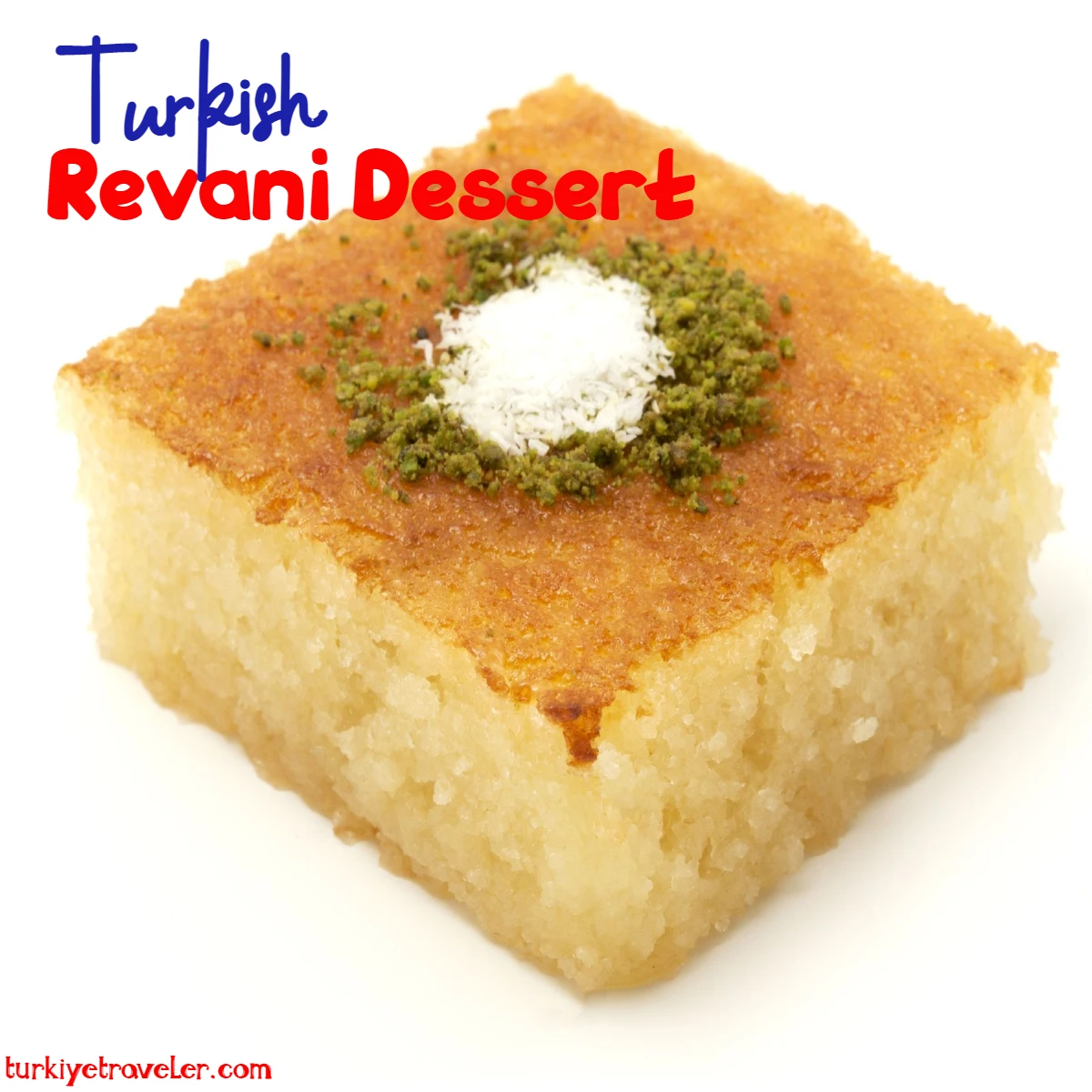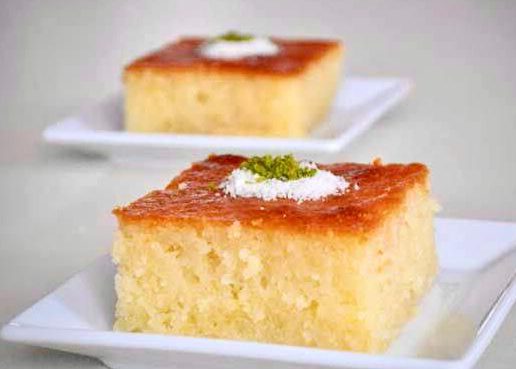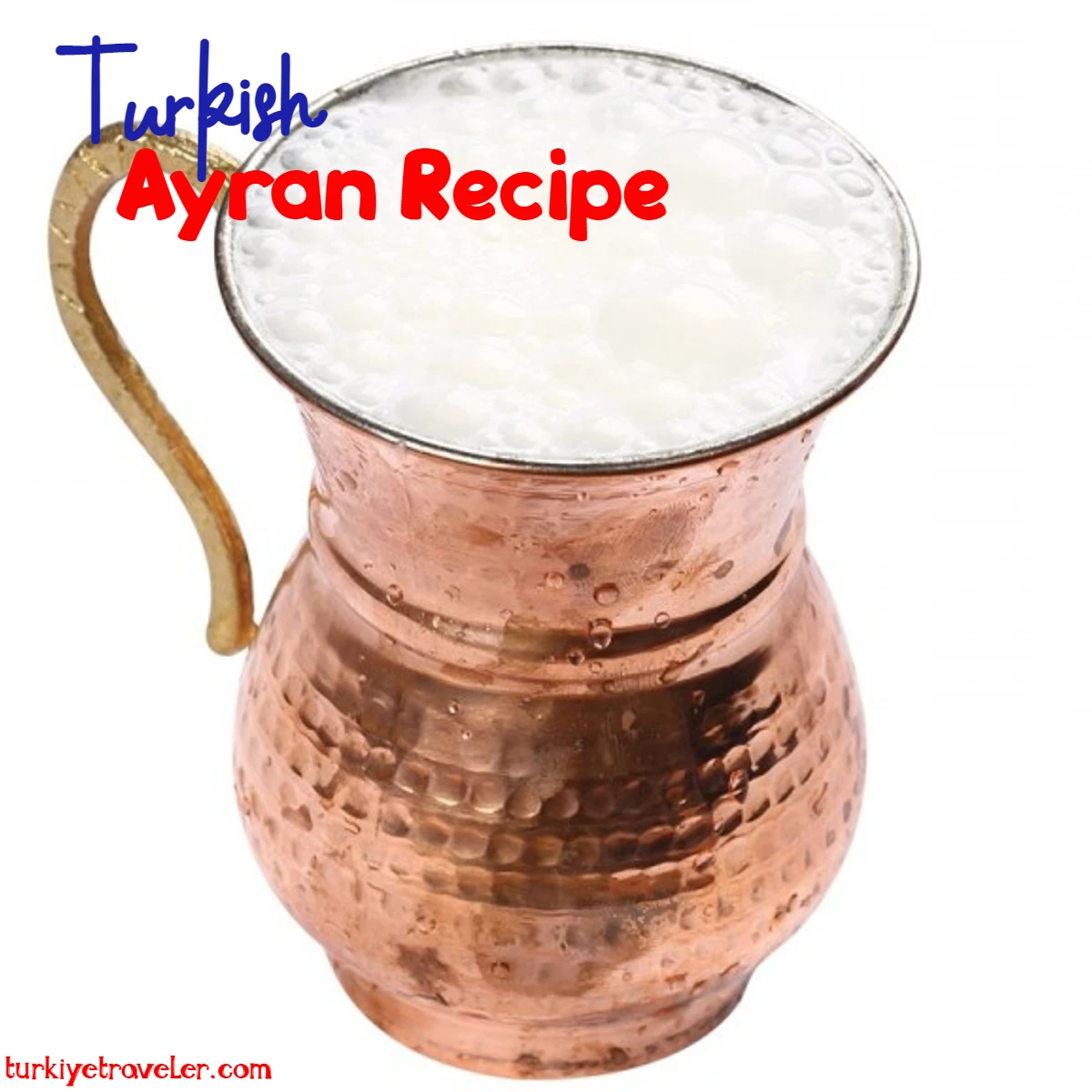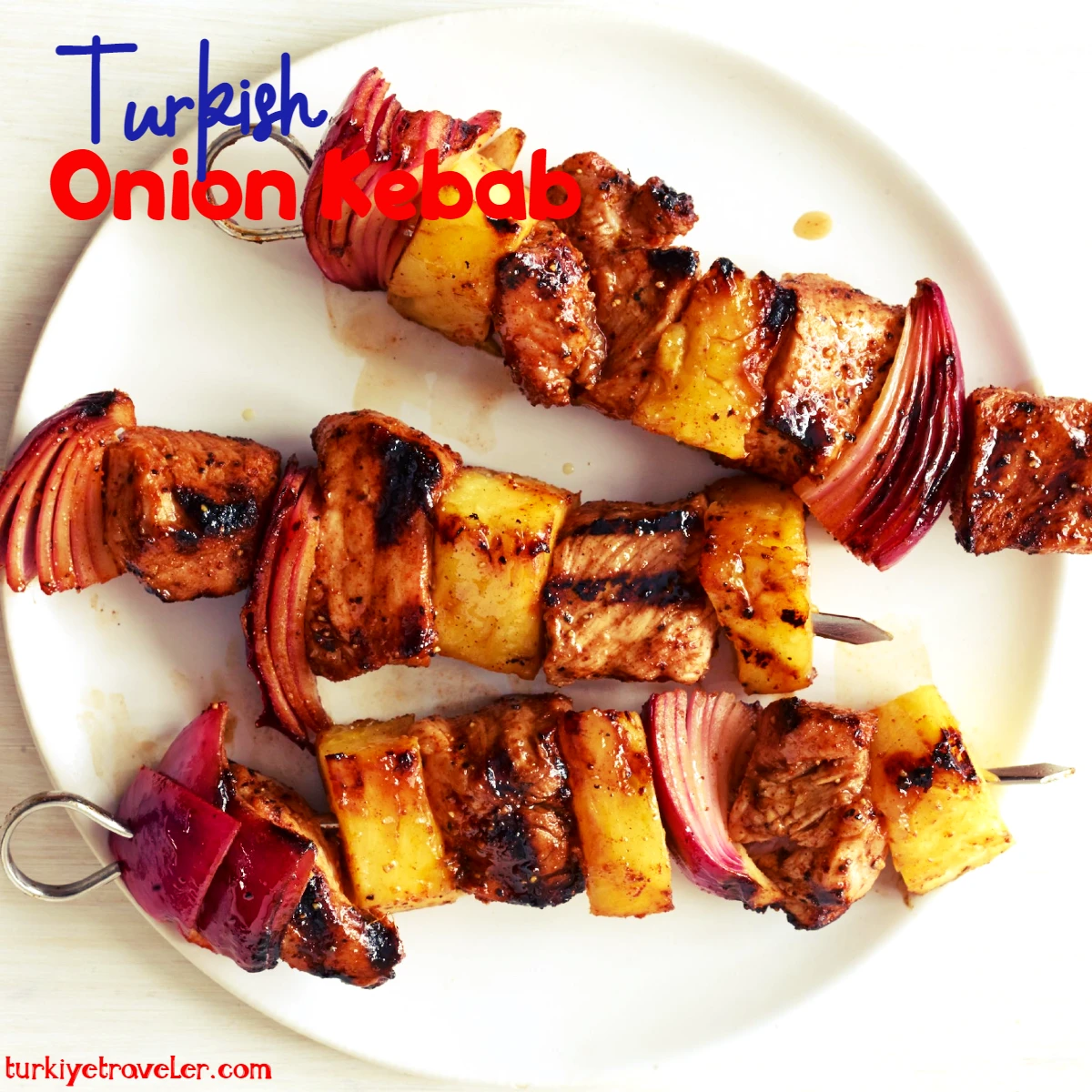
Turkish Revani is not just your ordinary cake. It’s a magical creation that weaves together the finest semolina flour, luscious syrup, and a touch of citrusy bliss. Picture a cake so tender and moist that it practically melts in your mouth, delivering a burst of flavors with each heavenly bite. The semolina adds a delightful graininess that sets it apart from traditional cakes, while the syrup drizzled on top seeps into every crevice, creating a symphony of sweetness.
If you have an adventurous spirit and an insatiable sweet tooth, it’s time to embark on a culinary escapade and try Turkish Revani dessert. Whether you’re a seasoned baker or a novice in the kitchen, this delightful treat is within your reach. So, gather your ingredients, preheat that oven, and let the aroma of freshly baked Revani fill your home. Get ready to impress your taste buds and indulge in the delectable embrace of Turkish Revani!
Are you ready to embark on a delightful journey of flavors and textures with Turkish Revani dessert? Join me in the next blog post, where we’ll dive deeper into the history and cultural significance of this beloved Turkish delicacy. Discover the secrets behind its creation, learn about regional variations, and unlock the key to mastering this heavenly dessert. Stay tuned and let Turkish Revani sweep you off your feet, one delicious slice at a time. Don’t miss out on this mouthwatering adventure!
Origins and History of Turkish Revani
To truly appreciate Turkish Revani dessert, we must first delve into its rich history and origins. This delightful creation has its roots in Ottoman cuisine, where it was favored by sultans and commoners alike. Named after the renowned Ottoman poet, Revani, this dessert has stood the test of time and continues to grace Turkish tables to this day.
The key ingredient in Turkish Revani is semolina flour, which adds a unique texture and character to the cake. Semolina, derived from durum wheat, is coarser than regular flour and gives the dessert its signature light and crumbly consistency. This ingredient has been a staple in Turkish cuisine for centuries, making its way into various traditional dishes, including the beloved Revani.
Turkish Revani Dessert Recipes (Revani Tarifi)
Course: DessertCuisine: Turkish DessertDifficulty: Easy4
servings15
minutes20
minutes415
kcal32
minutesWe expect an excellent revani dessert to not be too thin, so the size of the container we used for a thick dessert is very important. Your dessert will not be thin if you use an oversized tray. Anyone who has never tasted this delicious dessert made with semolina, which leaves lumps in your mouth when eaten, should try it out. Its soft cake, the main ingredient of semolina (which gives it a lumpy taste), can be eaten by the elderly without any problems.
Ingredients
- For the cake
3 eggs
1 glass Granulated Sugar
1 glass Yoghurt
1 glass Semolina
1 glass flour
1 packet vanilla
1 packet baking powder
1 teacup oil
- For Syrup
3 glass water
3 glass granulated Sugar
1/2 lemon
Directions
- First, prepare the syrup. For syrupt, take sugar and water into the pot and boil it.
- After it boils, add half a lemon juice, boil for 3-5 minutes, then turn off the heat.
- For the cake, add the egg and sugar into bowl then mix.
- Then add oil, yoghurt and semolina and whisk.
- Finally, add flour, baking powder and vanilla and whisk well.
- Grease the pan with oil and pour the cake batter into the baking dish.
- Bake in a preheated 170 degree oven for about 30 minutes, until the top is browned.
- Cut the cake into slices 3 minutes after taking it out of the oven and pour the cooled sherbet on the hot cake.
- After resting for 1-2 hours, you can add whipped cream, coconut or peanut etc. on it.
- Serve decorated with. Bon Appetit.
Recipe Video
Notes
- Semolina Flour: Use fine semolina flour for the best texture in your Revani. Coarser varieties can result in a grainy texture, which may not be desirable. You can find semolina flour in most grocery stores or specialty markets.
- Syrup Consistency: The syrup plays a crucial role in adding moisture and sweetness to the Revani. It should be warm when poured over the cake but not boiling hot. Ensure that the syrup has a thin consistency so that it can easily penetrate the cake and make it moist.
- Soaking Time: To achieve the perfect balance of moisture, it’s essential to let the Revani soak in the syrup for an adequate amount of time. Aim for at least 1-2 hours, or even overnight, for the syrup to fully infuse the cake and enhance its flavors.
- Citrus Zest: The addition of citrus zest, such as lemon or orange, adds a delightful aroma and tangy flavor to the Revani. Be sure to wash the citrus fruit thoroughly before zesting to remove any wax or residue.
- Cooling and Cutting: Allow the Revani to cool completely before cutting it into slices. This helps the cake to set and makes it easier to handle. For clean and neat slices, use a sharp knife and wipe it clean between each cut.
- Garnishing: While Turkish Revani is delicious on its own, you can enhance its visual appeal by garnishing it with crushed pistachios, shredded coconut, or even edible flowers. These toppings not only add texture but also make the dessert more visually appealing.
- Serving Temperature: Turkish Revani can be served at room temperature or chilled. Experiment with both options to see which you prefer. Chilling the Revani allows the flavors to develop further and provides a refreshing dessert experience.
- Storage: If you have leftovers, store the Revani in an airtight container in the refrigerator. It will stay fresh for a few days. Before serving again, you can bring it back to room temperature or enjoy it chilled, according to your preference.
Variations and Adaptations
As with any beloved dessert, Turkish Revani has inspired various adaptations and creative twists. Here are a few delightful variations you might want to explore:
- Citrus Infusion:
- Experiment with different citrus flavors to add a zesty twist to your Revani. Try using lime, grapefruit, or even a combination of citrus fruits for a burst of freshness.
- Nutty Indulgence:
- Enhance the texture and taste by incorporating chopped nuts into the cake batter. Walnuts, almonds, or pistachios work wonderfully and provide a delightful crunch.
- Aromatic Infusions:
- Take your Revani to new heights by infusing the syrup with aromatic flavors. Try using rose water, orange blossom water, or even a hint of cinnamon for a fragrant and exotic touch.
- Chocolate Infusion:
- For the chocolate lovers out there, why not add a decadent twist to your Revani? Melt some dark chocolate and drizzle it over the cake before pouring the sweet syrup. The combination of chocolate and syrup is pure indulgence.
Conclusion
Congratulations! You’ve successfully embarked on a journey into the delightful world of Turkish Revani dessert. From its humble origins to the exquisite flavors and textures, this semolina cake soaked in sweet syrup is a true masterpiece of Turkish cuisine.
Whether you’re hosting a dinner party, celebrating a special occasion, or simply treating yourself to a sweet delight, Turkish Revani is sure to impress and leave a lasting impression. So, gather your ingredients, follow the steps, and prepare to savor a slice of culinary heaven.
Don’t forget to share your Revani creation with friends and family, spreading the joy and deliciousness of Turkish cuisine. Now, it’s time to enjoy the fruits of your labor. Take a bite, close your eyes, and let the flavors transport you to the vibrant streets of Turkey.
Remember, the beauty of Turkish Revani lies not only in its taste but also in the memories and moments it creates. So, cherish each bite, savor each morsel, and let this dessert become a part of your own culinary story.
Thank you for joining me on this delightful journey, and may your future endeavors in the kitchen be filled with joy and culinary exploration. Happy baking and bon appétit!
FAQs
Turkish Revani dessert is a delightful semolina cake that originates from Turkey. It is known for its unique texture, achieved by using semolina flour, and its characteristic soaking process in a sweet syrup. The cake is often flavored with citrus, such as lemon or orange zest, adding a refreshing touch to its taste.
The basic ingredients for Turkish Revani dessert include semolina flour, all-purpose flour, sugar, yogurt, vegetable oil, eggs, baking powder, and citrus zest. The cake batter is prepared by whisking together the eggs and sugar, adding the yogurt, oil, and citrus zest, and gradually incorporating the dry ingredients. The batter is then baked in the oven until golden brown. After baking, a sweet syrup made from sugar and water is poured over the cake, allowing it to soak and infuse with sweetness.
Absolutely! Turkish Revani dessert offers room for customization and personalization. You can experiment with different flavors by using alternative citrus fruits like lime or grapefruit. Adding crushed nuts, such as pistachios or almonds, to the batter can provide a delightful crunch. Additionally, you can infuse the syrup with aromatic ingredients like rose water or cinnamon for a unique twist. Get creative and make Turkish Revani your own!
Turkish Revani dessert is typically served chilled or at room temperature. Once soaked in the sweet syrup and cooled, the cake can be cut into squares or diamond shapes for an attractive presentation. It is often garnished with crushed pistachios or shredded coconut, adding a touch of texture and visual appeal. Turkish Revani pairs well with a cup of Turkish tea or a refreshing glass of Ayran, a traditional yogurt-based drink.
es, Turkish Revani dessert can be made in advance. In fact, it is often recommended to let the cake rest and cool completely after soaking it in the syrup, as this allows the flavors to meld and develop further. Once cooled, you can store it in an airtight container in the refrigerator for a few days. This makes it a convenient dessert option for entertaining or special occasions.
No, Turkish Revani dessert is not gluten-free. It is traditionally made with semolina flour, which is derived from wheat and contains gluten. If you are following a gluten-free diet, you can explore alternative flours, such as gluten-free all-purpose flour or almond flour, to make a gluten-free version of Revani. However, keep in mind that the texture and taste may differ from the traditional recipe.
Turkish Revani dessert has gained popularity beyond the borders of Turkey. You may be able to find it in Turkish restaurants or bakeries in various parts of the world. Additionally, with the availability of recipes online, you can try making it at home to enjoy this delightful dessert no matter where you are.
Turkish Revani dessert can be suitable for vegetarians, as it does not typically contain any meat or animal by-products. However, it is important to check the specific recipe and ingredient list, as variations and adaptations may use ingredients like yogurt or eggs. To make a vegan version, you can explore plant-based substitutes such as non-dairy yogurt and egg replacers.
Read More:





